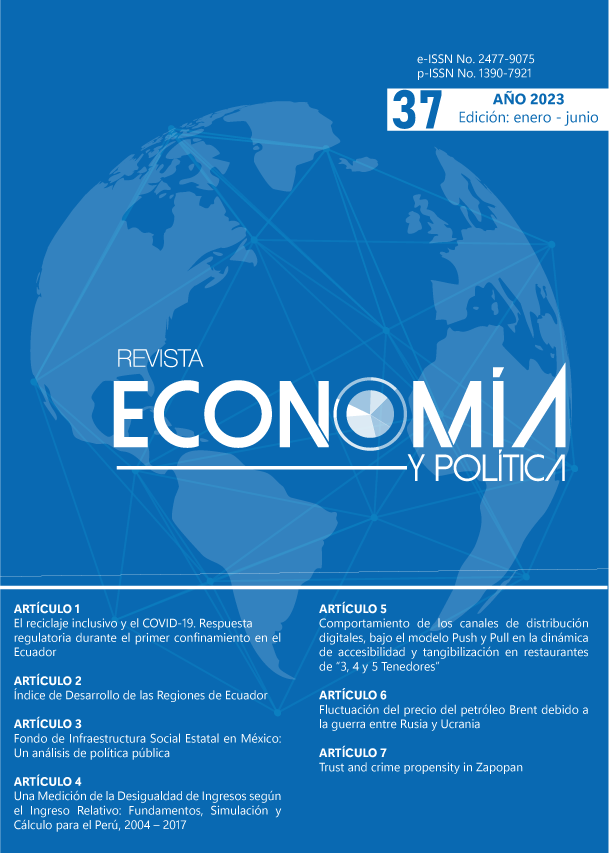El Comportamiento de los canales de distribución digitales, bajo el modelo Push y Pull en la dinámica de accesibilidad y tangibilización en restaurantes de “3, 4 y 5 Tenedores”
DOI:
https://doi.org/10.25097/rep.n37.2023.05Palabras clave:
Estrategias de servicio, Modelo push y pull, Precio, Producto, Promoción en ventas, RestaurantesResumen
El artículo estudia el comportamiento de los canales de distribución digitales directos como indirectos en restaurantes de “3, 4 y 5 Tenedores” de la ciudad de Cuenca para el período 2021. Analiza el manejo de estas tipologías de canal dentro del modelo Push & Pull, considerando la accesibilidad y tangibilización como factores de servicio. Se estudian elementos del marketing mix como producto, precio y promoción en ventas dentro del modelo aplicado a la distribución, a partir de herramientas como la observación estructurada y encuesta a gerentes de restaurantes. Los resultados indican que el producto ejerce presión en ambas tipologías. Sobre la tangibilización en canales directos, los elementos que aportan a esta estrategia son producto y número de objetivos de promoción, mientras que, en canales indirectos, ningún elemento del modelo contribuye a la misma, finalmente, el modelo Push & Pull no constituye un aporte para la accesibilidad de los restaurantes estudiados.
Descargas
Citas
Achenbaum, A., & Mitchel, K. (1987). Pulling Away from Push Marketing. Harvard Business Review. https://hbr.org/1987/05/pulling-away-from-push-marketing
Baena Gracia, V., & Moreno, M. de F. (2010). Instrumentos de marketing: decisiones sobre producto, precio, distribucion, comunicacion y marketing directo. Editorial UOC. https://elibro.net/es/lc/bibliotecautpl/titulos/33508
Belch, G. E., & Belch, M. A. (2007). Publicidad y Promoción: Perspectiva de la comunicación de marketing Integral (6ta ed.). Editorial McGraw-Hill.
Casielles, Rodolfo Trespalacios, J., Alonso, E., & González, C. (2011). Estrategias competitivas en canales de distribución comercial tradicional “versus” on-line (C. F. R. A. de D. C. Universidad de Oviedo (ed.)).
Cede. (2019). Diseño de ofertas gastronómicas. Tipos. Estructura, planificación y grupos de alimentos que las componen. Desarrollo de ejemplificaciones indicando posibles alternativas en los diseños. (p. 30).
Chen, B. X. (2020). Up to 91% More Expensive: How Delivery Apps Eat Up Your Budget. The New York Times. https://www.nytimes.com/2020/02/26/technology/personaltech/ubereats-doordash-postmates-grubhub-review.html?fbclid=IwAR0TiSrwaO-HfNpU0ENZV_LsNbmY7LomtcJUlzskBxWC-HuHoKgeQCb7aBI
Cho, S.-E., & Park, K. (2003). Characteristics of product/service process and customer needs of geographical accessibility in electronic commerce. International Journal of Service Industry Management, 14(5), 520–538. https://doi.org/10.1108/09564230310500200
Chong, J. L., Aizpuru, M., Cárdenas, A., Espinal, E., Gómez, L. L., Koehn, C., López, M., Lozano, C., Mendoza, G., Moya, J., Pedrote, Á., & Trueba, G. (2009). Promoción de Ventas. Granica.
Clancy, K., & Shulman, R. (1998). La Revolucion del Marketing. Javier Vergara Editores.
Dakduk, S., & Dicarlo, R. (2020). Situación de las empresas durante el COVID-19 Ecuador. https://cece.ec/wp-content/uploads/2020/06/Transacciones-electronicas-en-Ecuador-durante-el-Covid19.pdf
De Juan Vigaray, M. D. (2004). Comercialización y “retailing”: distribución comercial aplicada. P.E.S.A.
Donnelly, J. H. (1980). Intangibility and Marketing Strategy lot Retail Bank Services. Journal of Retail Banking, 2, 39–43.
Fine, L. M. (2008). Services marketing Integrating Customer Focus Across the Firm. In Business Horizons (Séptima Ed, Vol. 51, Issue 3). Mc Graw Hill. https://doi.org/10.1016/j.bushor.2008.01.008
Fischer, L., & Espejo, J. (2011). Mercadotecnia (4ta ed.). McGraw Hill/Interamericana Editores S.A.
García, M. S., Ruíz, A. L., & Tamayo, U. (2000). Las operaciones comerciales electrónicas: repercusiones en la cadena logística. Ditribución y Consumo, 10(55), 51–66.
Giraldo Oliveros, M., Juliao Esparragoza, D., & Acevedo Navas, C. (2017). Gerencia de marketing. Ecoe Ediciones. https://elibro.net/es/lc/bibliotecautpl/titulos/122439
Gunden, N., Morosan, C., & DeFranco, A. (2020). Consumers’ intentions to use online food delivery systems in the USA. Emerald Insight, 32(3), 1325–1345. https://doi.org/10.1108/IJCHM-06-2019-0595
Gupta, V., & Duggal, S. (2020). How the consumer’s attitude and behavioural intentions are influenced: A case of online food delivery applications in India. INTERNATIONAL JOURNAL OF CULTURE, TOURISM AND HOSPITALITY RESEARCH. https://doi.org/10.1108/IJCTHR-01-2020-0013
Hoffman, K. D., & Bateson, J. G. E. (2011). Marketing de Servicios: Conceptos, estrategias y casos. (4ta ed.). Cengage Learning.
Keller, K. (2008). Administración Estratégica de Marca (Tercera Ed). Pearson Educación.
Kotler, P., & Armstrong, G. (2014). Marketing (15th Ed). Pearson Educación.
Kotler, P., & Keller, K. L. (2016). Dirección de Marketing (15th Ed.). Pearson Educación.
Krentler, K. A., & Guiltinan, J. R. (1984). Strategies For Tangibilizing Retail Services: An Assessment. Journal of the Academy of Marketing Science, 12(4), 77–92.
Kucuk, S. U. (2011). Push-based brand awareness: The role of product availability and in-store merchandising. International Review of Retail, Distribution and Consumer Research, 21(3), 201–213. https://doi.org/10.1080/09593969.2011.578793
Lichtenstein, N. (2020). The Hidden Cost of Food Delivery. Tech Crunch. https://techcrunch.com/2020/03/16/the-hidden-cost-of-food-delivery/?guccounter=1
Ministerio de Turismo. (2018). Reglamento Turístico de Alimentos y Bebidas. https://www.gob.ec/sites/default/files/regulations/2018-10/Reglamento Turístico de Alimentos y Bebidas.pdf
Mullins, J. W., Walker, O. C., Boyd, H. W., & Larréché, J.-C. (2007). Administración del Marketing: Un enfoque en la toma estratégica de decisiones (5ta ed.). McGraw Hill/Interamericana Editores.
Narasiham, C. (1990). Managerial Perspetives on Trade and Consumer Promotions. Marketing Letters, 1, 241.
Olson, J. C., & Dover, P. (1979). Effects of Expectation Creation and Disconfirmation on Belief Elements of Cognitive Structure. Advances in Consumer Research, 3, 168–175.
Paz, H. R. (2008). Canales de Distribución: Gestión Comercial y Logística (3era ed.). Lectorum - Ugerman.
Pesántez, F. (2019). Clases Magistrales.
Rodríguez Ardura, I., Ammetller Montes, G., López Prieto, Ó., Maraver Tarifa, G., Martínez Argüelles, M. J., & Jiménez Zarco, Ana Isabel Codina Mejón, Jaume Martínez López, F. J. (2008). Principios y estrategias de marketing (Universitat Oberta de Catalunya (ed.)). Editorial UOC. https://www-digitaliapublishing-com.eu1.proxy.openathens.net/a/20486/principios-y-estrategias-de-marketing
Serrano Gómez, F., & Serrano Domínguez, C. (2005). Gestión, Dirección y Estrategia de Producto. ESIC Editorial.
Shapiro, B. (1977). Industrial Product Policy: Managing the Existing Product Line. Cambridge Marketing Science Institute.
Vaquero Gonzalez, J. (2013). Operaciones basicas de restaurante y bar: servicio basico de restaurante-bar. Editorial CEP, S.L. https://elibro.net/es/lc/bibliotecautpl/titulos/50740
Zaragoza, C. (2021). Archivo Etiqueta: Restaurantes. https://www.camarazaragoza.com/tag/restaurantes/
Publicado
Cómo citar
Número
Sección
Licencia
Derechos de autor 2023 Revista Economía y Política

Esta obra está bajo una licencia internacional Creative Commons Atribución-NoComercial-CompartirIgual 4.0.






